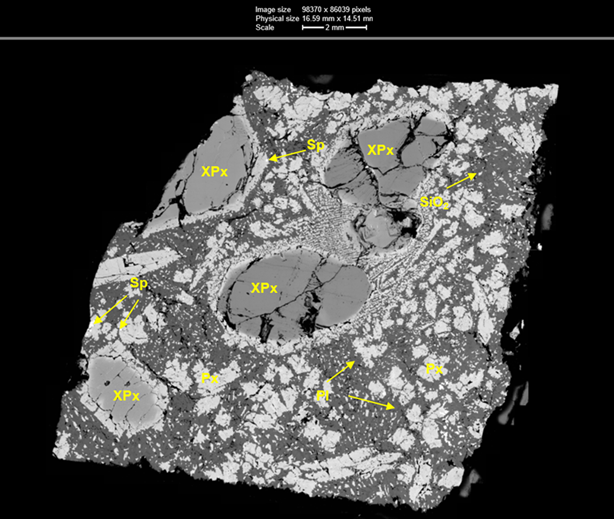Meteoritic evidence for very early volcanism in the nascent solar system
Scientists from Freie Universität Berlin, University of Bristol, Northwest University Xi'an and the Institute of Geochemistry of the Chinese Academy of Sciences have published the results of a new determination of the crystallization age of 4566.6 ± 0.6 million years for a meteorite called Erg Chech 002 (EC 002). The new age, determined using the manganese-chromium dating method, shows this rock crystallized only 0.7 ± 0.6 million years after the formation of the solar system.
News from Jul 26, 2022
“This makes the meteorite at present the oldest known volcanic rock in the solar system”, as Dr. Ke Zhu, a former Alexander von Humboldt postdoctoral fellow at Freie Universität and now at University of Bristol, explains. At the same time, the age of the rock represents a minimum age for crust formation on its parent body and thus shows that separation into crust and mantle occurred very early. Based on additional isotope data for the elements chromium and oxygen, the scientists conclude that EC 002 likely is related to a group of meteorites called brachinites, which originate from the inner solar system. “The different textures and compositions of EC 002 and the brachinites could imply the existence of a chemically heterogeneous parent body or the existence of multiple parent bodies with distinct chemical composition” says Prof. Harry Becker of Freie Universität Berlin. The dating result requires that the parent body of EC 002 must have grown within a few hundred thousand years since the formation of the solar system, which corresponds to the time scale of astrophysical growth models of such small bodies. The study was published in the in the journal Monthly Notices of the Royal Astronomical Society Letters.
Previous studies of the meteorite, which was found in Algeria in 2020, have shown that EC 002 represents solidified magma which formed new crust as volcanic rock near the surface of its parent body. The rock is relatively rich in silicon, similar to rocks on Earth called andesites. Shi-Jie Li, staff scientist in Institute of Geochemistry, CAS, who provided this sample concludes “because rocky planets yield significantly younger ages, the parent body may have been an asteroid. However, the composition of the meteorite suggests a chemically more variable crust compared to typical asteroids which have basaltic crust”. The heat source for such early magmatism on asteroids is believed to be the radioactive decay of 26-aluminum, which was present in the early solar system, but then decayed within a few million years.
Technological advances over the past 20 years have led to groundbreaking insights into the formation and early geological evolution of planets and asteroids. By simulating physical processes with computers, it was proposed that asteroids and rocky planets grew to their present size in a geologically short time, ranging between a few ten thousand to about a hundred million years after the formation of the solar system. Significantly improved methods of isotope analysis for provenance studies and dating of meteorites allow these hypotheses to be tested. The new study shows that we can now resolve time differences of a few hundred thousand years for geological processes on 4.6 billion years old parent bodies of meteorites.
Further information:
Dr. Ke Zhu, School of Earth Sciences, University of Bristol, Email: ke.zhu@bristol.ac.uk
Prof. Harry Becker, Institut für Geologische Wissenschaften, Freie Universität Berlin, Email: hbecker@zedat.fu-berlin.de
Prof. Tim Elliott, School of Earth Sciences, University of Bristol, Email: tim.elliott@bristol.ac.uk
Dr. Shi-Jie Li, Center for Lunar and Planetary Sciences, Institute of Geochemistry, CAS, Email: lishijielpsc@mail.gyig.ac.cn
Publication:
Zhu, K., Becker, H., Li, S.-J., Fan, J., Liu, X.-N., Elliott, T.: Radiogenic chromium isotope evidence for the earliest planetary volcanism and crust formation in the Solar system. Monthly Notices of the Royal Astronomical Society Letters, 515, L39-L44. https://doi.org/10.1093/mnrasl/slac061
Figure: Back scattered electron image showing the fabric of EC 002 in a thin section. Large crystals of the mineral orthopyroxene occur in a more fine-grained matrix of feldspar, pyroxene and other minerals. The length of the bar in the header is 2 mm. Image credit: Shi-Jie Li.
